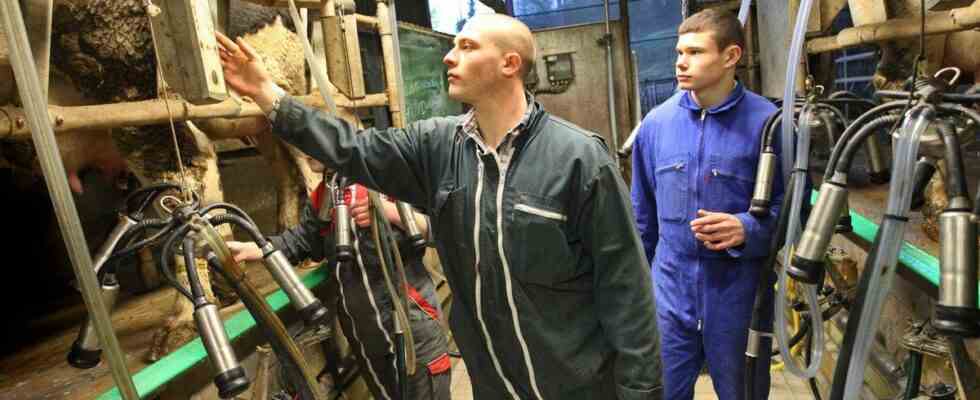It is a success of which we speak little. But it is clear that agricultural high schools are more and more popular. According the last numbers of the Ministry of Agriculture, at the start of the school year, the 217 public and 207 private agricultural high schools welcomed 156,000 students in initial training, from 4th to BTSA (compared to around 135,000 in 2021). “The increase in numbers has been constant since 2010 while we are witnessing a demographic decline in secondary education at the national level”, explains to 20 minutes the entourage of the Minister of Agriculture, Marc Fesneau.
A third of the students follow general and technological training ranging from 4th grade to preparatory classes. The remaining two-thirds follow vocational training (CAP agricole, vocational baccalaureate, BTSA). At present, several training courses are particularly popular: the professional baccalaureate Services to people and territories, the professional baccalaureate Horticultural production, the BTSA Analysis, conduct and strategy of the company, the CAPa Forestry works, the BTSA Management and protection of nature…
Formations that are better known to the general public
So many formations that attract a fairly heterogeneous audience. “While in 1990, nearly four out of ten students were children of farmers or agricultural workers, they now represent only one out of ten students. The children of employees and workers are the most numerous to attend agricultural education establishments, they represent 43% of the workforce”, indicates the Ministry of Agriculture. And the feminization of the workforce is improving, since 45% of students are now girls. Even if some sectors are still too gendered: “Training in the field of animal production is very masculine, and those dedicated to personal services very feminine”, underlines Clémentine Mattei, co-secretary general of Snetap-FSU, national union of the State agricultural technical education.
If agricultural training courses have met with greater success in recent years, it is primarily because they are better known by young people. And this in particular thanks to a major digital communication campaign aimed at middle and high school students and the general public launched in 2019. young people in our training,” confirms Clémentine Mattei. “Very often, the general public thinks that agricultural colleges only train farmers. And there, they were able to discover the whole range of trades in which they train”, adds Didier Fleury, Secretary General of SEA-UNSA (agricultural education union).
The boarding school, a factor of attractiveness
But if this teaching seduces, it is above all because it meets the aspirations of many young people. “Their strong sensitivity to ecology means that they want to find a job that allows them to feel useful and to be in agreement with their convictions”, believes Clémentine Mattei. This offers them a wide range of outlets. They can move towards a trade in the agricultural or agri-food sector, the forest-wood sector, a profession linked to the preservation and enhancement of natural environments, the maintenance and creation of landscaping, services for the elderly or early childhood in rural areas…
Young people who visit high schools during their open days are also attracted by the boarding school. Because agricultural high schools are generally located in rural or peri-urban areas, 57% of students from the 4th to the bac are internal. “It allows young people who have family difficulties to benefit from good learning conditions”, underlines Didier Fleury.
A pedagogy that promotes practice
The pedagogy implemented is also an asset: “The students do a lot of ground work because the high schools have farms, technological workshops or equestrian centers within their walls which allow the students to put their skills into practice. And they work a lot in the form of projects, ”describes the entourage of the Minister of Agriculture. “The teams practice multidisciplinarity. It is not uncommon to see, for example, a Biology-Ecologist teacher, his History-Geo colleague and another in Economics-Management taking part in the same course on farming” Clémentine Mattei, “Les practical work makes learning more concrete,” adds Clémentine Mattei
“Many young people also want to come because our establishments are on a human scale, with classes of 20 to 25 students. This helps to motivate some students with great academic difficulty”, also underlines Didier Fleury. The motivation of the students, precisely, partly explains their good results in the exams. Thus, at the session last June, the success rate for the CAPa was 99%, 97% for the professional and general baccalaureate, 86% for the professional baccalaureate and 78% for the BTSA.
A good professional integration
And graduates fit rather quickly into the professional world. “Among those who entered working life three years after obtaining their diploma, 76% of holders of an agricultural CAP, 86% of baccalaureate holders and 92% of BTSA graduates are in employment”, informs the entourage. by Marc Fesneau. And we will need them even more in the coming years: “One in two farmers will retire in five years. However, today, 12,000 installations take place per year, whereas 20,000 are needed, ”underlines Clémentine Mattei. “These young people have a role to play in the transition that must be carried out, in particular agro-ecological,” adds the ministry.

